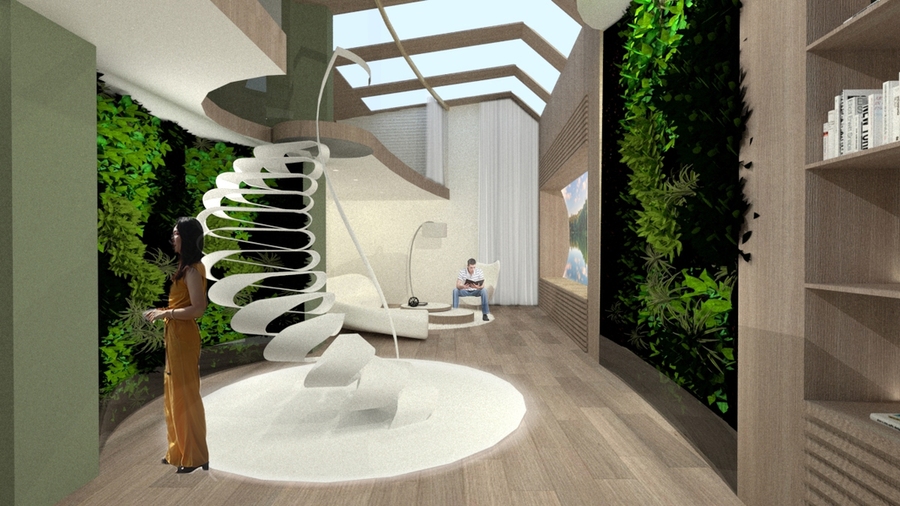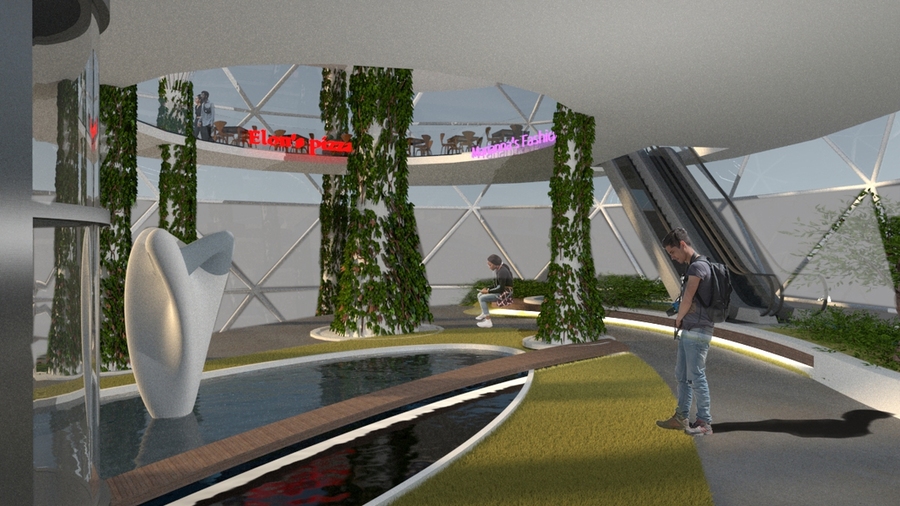Every 75 years, Halley’s Comet makes a triumphant return to the inner solar system, becoming visible to the naked eye from the Earth’s surface as it streaks across the night sky. In 1986, brothers George and Alexandros Lordos, who helped found the astronomy club at their high school in Cyprus, decided they were not going to miss this once-in-a-lifetime opportunity despite the cloudy weather.
“Together with friends, we borrowed camping supplies from the hiking club and hiked up familiar terrain on Troodos Mountain to a cloudless spot that was 5,000 feet above sea level, miles away from city lights” says George Lordos, MBA ’00, SM ’18. “When we unzipped our tent at 3 o’clock in the morning, Halley’s comet was right in front of us, in all its glory. It was like seeing a ghost ship floating on a sea of stars.”
Recently, the brothers again combined their shared passion with their professional expertise to team up and develop Star City, a concept for a human city on Mars. Their design won first place at the Mars Colony Prize Design contest, which was hosted by the Mars Society and judged by a panel that included experts from NASA and SpaceX.
Today, Lordos is a PhD candidate in the Engineering Systems Laboratory at MIT’s Department of Aeronautics and Astronautics and the head teaching assistant at MIT’s System Design and Management Program, researching sustainable human space settlement architectures with professors Olivier de Weck and Jeffrey Hoffman. His brother, Alexandros Lordos, is currently the director of the Center for the Study of Life Skills and Resilience at the Department of Psychology at the University of Cyprus, and head of learning and innovation at the Center for Sustainable Peace and Democratic Development, researching the development of integrated systems to foster mental health and social cohesion in countries facing conflict-related adversities.
“In addition to addressing the engineering requirements to put humans on Mars, the overall philosophy of our approach was to provide the residents with a diverse array of capabilities, rather than ready-made solutions, relying on the human capacity to be resourceful and resilient in addressing the many unknown challenges that will arise,” says Lordos. “This ensures not only their survival, but also that their well-being, agency, and capacity to grow will be duly considered so they may thrive there as well.”
The goal of the competition was to establish a successful colony on Mars for 1,000 residents. One hundred entrants from around the world submitted proposals, which were eventually narrowed to 10 finalists who presented their proposals at the 22nd Annual Mars Society Convention in October. The criteria for the judges’ consideration included technical merit, economic viability, social and political organization, and aesthetics.
Using abundant energy supplies and heavy equipment, Star City’s residents will first focus on carving out habitats by tunneling inside a crater rim to create networks of living and work spaces. By working with the natural topography of Mars, the residents will be able to develop large habitable spaces that will be safe from radiation and other dangers. At the same time, the excavated material will be mined for water and useful minerals that can then support local industry and the growth of self-sustaining crops through hydroponics. From there, they would continue to build around the crater rim to create residential and commercial areas that contain shops, restaurants, and libraries, eventually pooling their resources to develop the city’s central hub, which will house Mars University and other shared facilities.
“The idea is to start with five distinct villages that will be constructed around the crater rim, each aiming for a population of 200 residents within a decade of the first landing, and originating from different Earth continents,” says Lordos. “The five villages will interconnect their tunnel networks and focus on continuous growth of their habitats, capabilities, stocks of resources, and quality of life.”
According to Alexandros, the wheel-like physical layout is one of the key mechanisms to build an organic sense of community among Star City residents, which is essential to their well-being as they navigate the challenges of living together on a distant planet. Proximity will enable each village to have access to the other four for material and social support, inspiration, leisure, new ideas, different solutions to common challenges, and socialization. By teaming up to address survival challenges and achieve aspirational goals, they will establish a support network completely unique to Star City so residents can better navigate through times of difficulty.
“Drawing on cumulative insights from the social sciences and our own experience in developing systems to support societies facing extreme adversities, we have identified core aspects of the human condition that will be relevant for socio-economic development on Mars,” says Alexandros. “Specifically, we considered the pivotal role that individual as well as community resilience will be expected to play on Mars, sought to ensure a balance between survival-orientation and self-expression in everyone’s daily life, while making room for Star City residents to develop multi-layered identities as members of their more intimate village communities and, at the same time, as citizens of a vibrant and forward-looking technological civilization.”
In addition to building community by nurturing the well-being of its human residents, Star City will also build a viable economy and political system to ensure that commerce and governance provide stability for its residents. To pay for importing much-needed supplies from Earth in the short term, Star City residents will leverage their local know-how, infrastructure, and heavy equipment to provide construction services to others who may wish to build a city on Mars. In the long term, Star City could establish itself as a central hub for innovation, entrepreneurship, and tourism as humanity travels farther and farther into the reaches of space.
“Our vision is not to simply send human explorers to Mars in order to set up these scientific outposts where we can perform useful experiments, though that is an important and valuable component,” says Robert Zubrin, president of Pioneer Astronautics and the founder and president of the Mars Society, who organized the contest and served on the panel of judges. “The fundamental question we are asking is if we can expand human civilization into other worlds. Of course, you have to have the correct technical analysis, but there are all of these other human dimensions to make a colony on Mars work, and Star City addressed those in the most successful way.”
The Star City sociotechnical concept and urban plan was created by George and Alexandros Lordos, with architectural support for the creation of design studies, drawings, and renderings by lead architects Nikos Papapanousis and Tatiana Kouppa, and their team members Efi Koutsaftaki, Aliki Noula, and Aris Michailidis of Delta Architects, Athens, Greece.















